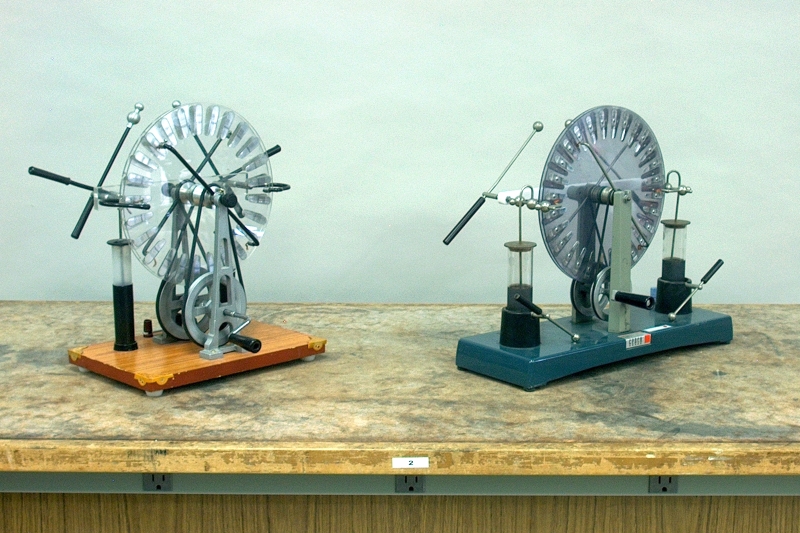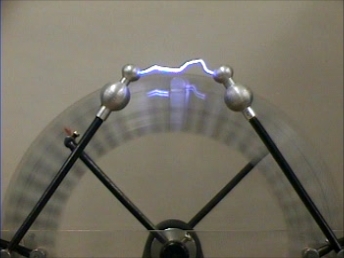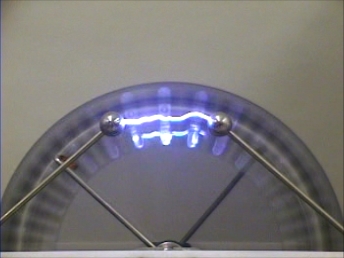
A video of this demonstration is available at this link.
Turn the crank (in the clockwise direction) on either of these machines, and in a short while, periodic arcs occur between the two electrodes on the back of the machine:
The Wimshurst machine is a type of influence machine, that is, one in which charge separation is accomplished solely by means of induction, as opposed to triboelectricity. It gets its name from James Wimshurst (1832-1903), an English inventor, engineer and shipwright, and is the result of his improvements on the designs of other machines of the time.
This machine has two counter-rotating plastic discs (notice that the drive belt on the rear disc is crossed), each of which has a series of metal sectors, which are mounted radially near the edge, equally spaced from each other. Mounted in front of each disc is a “neutralizer” bar (sometimes called an “equalizer” bar), each end of which makes electrical contact with the disc via a brush. The two neutralizer bars are mounted perpendicular to each other, each along a NW-SE line as you face its respective disc. At either end of a horizontal line through the center of the discs is a pickup, each of which is connected to a ball electrode. In the model at right in the photograph above, each pickup is also connected to the inner conductor of a Leyden jar (capacitor), and the outer conductor of each Leyden jar is connected to the metal baseplate via a lever, by means of which you can break the connection to each Leyden jar and so choose whether to keep one or both in the circuit. In the machine at left, the outer conductors of the two Leyden jars are tied together by a removable shunt (one end of which, with its binding post, is visible to the left of the drive pulley for the rear disc), and the inner conductor of each Leyden jar is connected to its respective pickup via a lever, which you can move to take the Leyden jar out of the circuit.
What enables this machine to start is that although objects are electrically neutral, their charge distributions can fluctuate, so that while there is no net charge on an object, at any given time, in a particular spot, it may have a slight excess of charge of one sign or the other (which is compensated by a similar excess of charge of the opposite sign elsewhere). Thus, when we start the plates of the Wimshurst machine rotating, a particular sector may have a slight positive or negative charge on it. For example, let us say that it is a positive charge, and it is the sector on the front plate at the top right. Let’s call it sector A, and say that it is just opposite the sector on the rear plate that touches the neutralizer bar on the back of the machine, which we’ll call sector B. This positive charge on sector A induces a negative charge on the back surface of sector B, by repelling the positive charges to the front surface, where they are carried away by the neutralizer bar. (Electrons flow from the opposite end of the neutralizer bar.) This leaves sector B with a net negative charge, and the sector on the rear plate 180 degrees from it with a net positive charge. The resulting polarization of the neutralizer bar charges the sectors immediately following B negative, and those immediately following the one 180 degrees from it, positive. 45 degrees later in the rotation, sector A passes the pickup at right, and transfers its charge to the Leyden jar. In another 45 degrees, sector B (negative) is opposite the sector on the front disc that touches the top of its neutralizer bar, and it induces a positive charge on this sector. The neutralizer bar carries away the negative charge to make the sector 180 degrees from it negative. As described for the operation of the first neutralizer bar, the polarization of this neutralizer bar charges sectors immediately following the top one positive, and those immediately following the bottom one negative. Another 45 degrees of rotation brings sector B to the pickup on the left, where it deposits its negative charge. These cycles continue until on the front disc, all of the sectors from the top of the neutralizer bar to the pickup on the right are charged positive, and those from the lower end of the neutralizer bar to the left-hand pickup are charged negative. On the rear disc, all the sectors from the top of the neutralizer bar to the left-hand pickup are charged negative, and those from the bottom of the neutralizer bar to the right-hand pickup are charged positive. Thus, at either pickup, the sectors on both discs have the same charge (positive at the right-hand pickup, negative at the left-hand one), which is repelled from the sectors into the Leyden jar (or just onto the electrode, if the Leyden jar is not connected). The sectors on either disc between either pickup and the nearer end of the neutralizer bar, having deposited their charge into their respective Leyden jars, are neutral. As the number of charges in each Leyden jar increases with each cycle, so does the potential difference between the two ball electrodes, until this potential difference equals that necessary to break down the air between them, and the two Leyden jars discharge in an arc, as shown in the two smaller photographs above. As you continue cranking, the process begins again, causing charge to build up in the Leyden jars until another arc occurs and discharges the Leyden jars. If you disconnect the Leyden jars, the capacitance of the system becomes small enough that the breakdown voltage is reached almost immediately, and there is a virtually continuous arc between the electrodes. This is difficult to see, sometimes even with the lights out, but you can almost always hear the sizzle of this almost continuous discharge.
We could have chosen to begin with negative charge on sector A. The mechanism would have been identical, except that all of the charges would have had opposite sign, and the left-hand Leyden jar would have been positive and the right-hand one negative. This type of process, which begins with a small charge separation that creates an ever-increasing one is often referred to as being self amplifying. It takes work to move the positive and negative charges onto their respective electrodes, and into their respective Leyden jars. You provide this work as you turn the crank that causes the discs to rotate. Thus, this machine converts mechanical energy into electrical energy.
Because the initial induction and polarization steps require conduction of charge from the polarized sector (B in our example) to another sector to establish the charge on these sectors, the neutralizer bars must make direct electrical contact with the discs. This is usually done by means of conductive tinsel, bundles of fine wire, or copper braid. It is possible, however, to carry the charge from the discs into the electrodes and Leyden jars either by direct electrical contact or by means of corona discharge. Whereas the pickups on the machines shown above use direct contact, on some models they have combs, rows of pins, or just a few pins, which face the surface of each disc, but do not directly touch it. The high fields around the teeth of the combs, or at the points of the pins, give rise to corona discharge, which pulls the charge off the discs and into the electrodes and Leyden jars. Because of the orientation of the neutralizer bars, these machines work only if you crank in the clockwise direction. If you crank in the counterclockwise direction (assuming that the crank on the machine at left does not unscrew from the shaft), the induction and charge transfer steps cannot occur as described above, and the machine does not work. For operation in this direction, you would have to change the orientation of the neutralizers to a NE-SW axis (and make sure that the crank would hold to the shaft; on both machines above, it is held onto the shaft by a right-handed screw thread).
The Leyden jars on the machine at right are larger than those on the machine at left, so the charge accumulated to reach the breakdown voltage is greater than for the other one, and its arcs are significantly more intense, as the photographs show.

